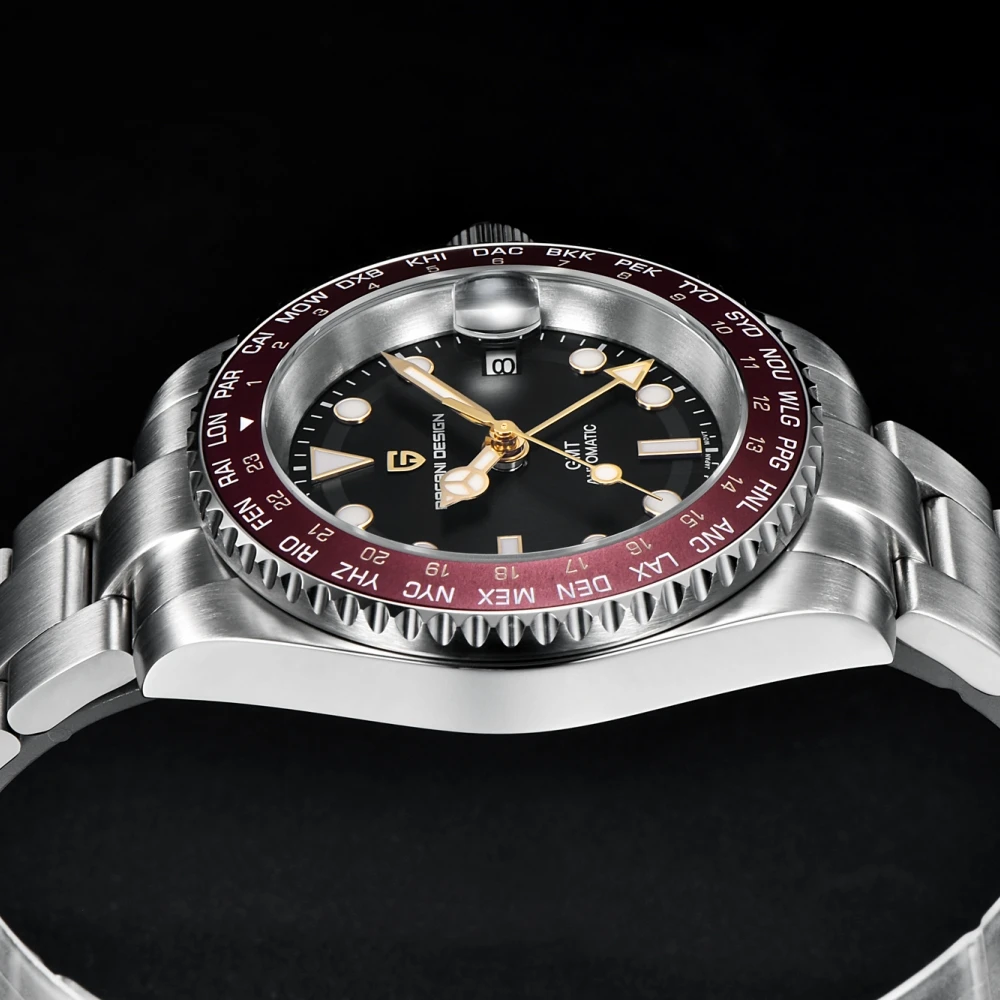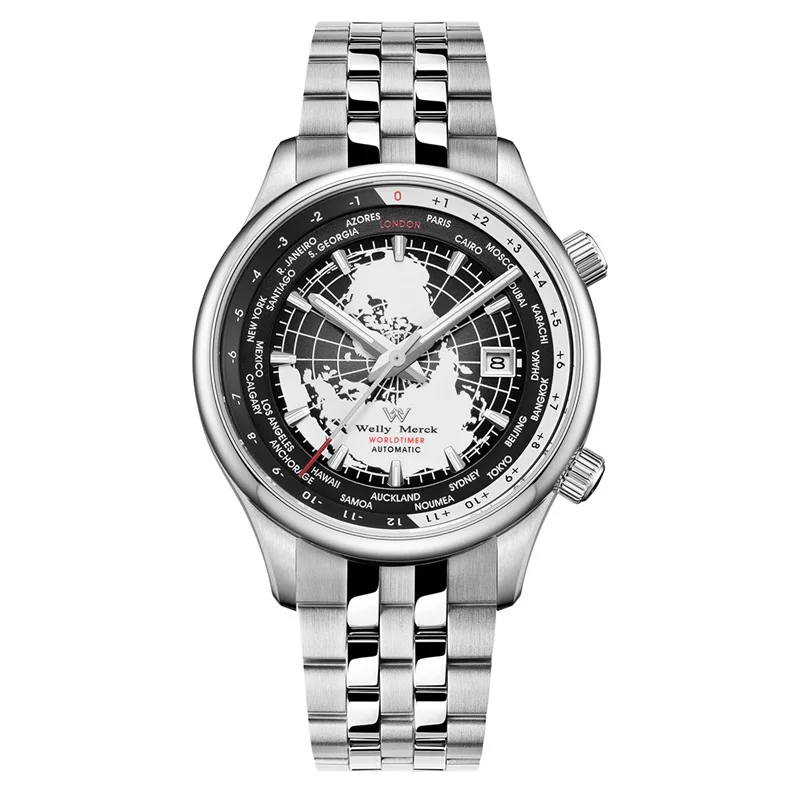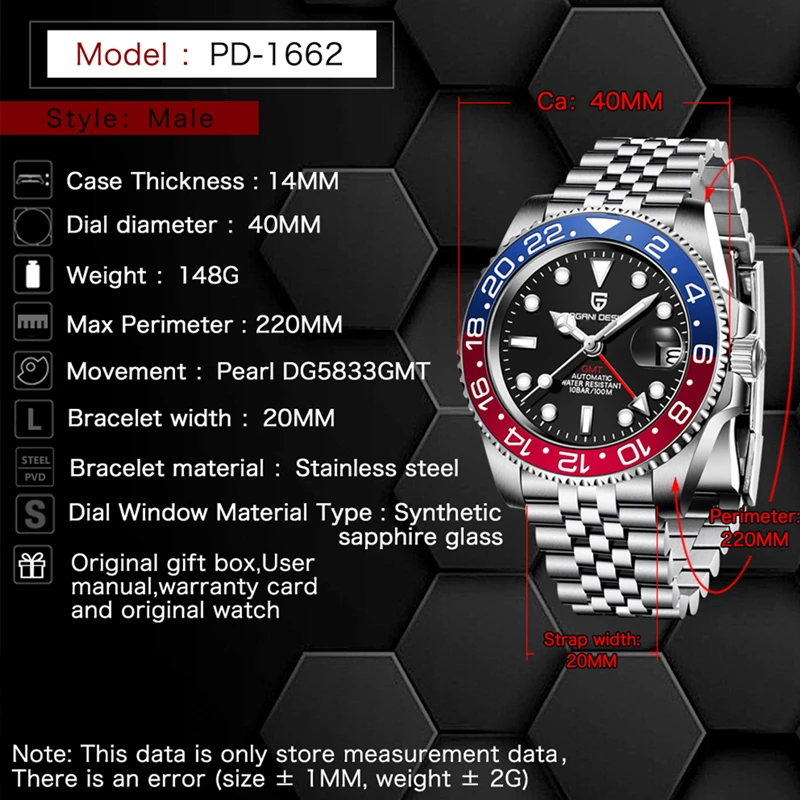Understanding GMT Watches: The Traveler’s Essential Timepiece
For frequent travelers who cross time zones, keeping track of time can be challenging. This is where GMT watches shine as the perfect travel companion. A GMT watch is a specialized timepiece designed to display multiple time zones simultaneously, allowing travelers to keep track of local time while maintaining awareness of the time back home.
The GMT watch concept originated in the 1950s when Pan American Airways commissioned a timepiece for their pilots who were flying across different time zones. The watch was designed to display Greenwich Mean Time (GMT) – the global time standard now known as Coordinated Universal Time (UTC) – alongside the local time, helping pilots coordinate flight plans and communications.
What makes a GMT watch different from standard watches or even world timers is its elegant simplicity. While world timers display all 24 time zones at once, GMT watches typically track just two or three time zones, making them more readable and practical for most travelers.
Key benefits of GMT watches for travelers include:
- Simultaneous tracking of home and local time
- Easier scheduling of calls and meetings across time zones
- Reduced jet lag through better time awareness
- Independence from electronic devices that may run out of battery
The rich history of dive watch engineering shares similar development paths with GMT watches, both being created to solve specific professional needs. Today’s travelers find numerous GMT dive watch use cases beyond just telling time, making them essential tools for modern globetrotters. Sharp Aspect offers an extensive collection of GMT automatic watches designed specifically with travelers in mind.
The Mechanics of GMT Watches: How They Track Multiple Time Zones
Understanding how GMT watches work helps travelers make the most of this valuable tool. The defining feature of a GMT watch is its additional fourth hand – the GMT hand – which makes one complete rotation every 24 hours (unlike the regular hour hand that rotates twice daily).
This GMT hand works in conjunction with a 24-hour scale, typically displayed on the bezel or on the dial itself. The 24-hour format eliminates any confusion between AM and PM hours across different time zones. Here’s how the system works:
- The standard hour, minute, and second hands show the current local time as normal
- The GMT hand points to the second time zone (often home time) on the 24-hour scale
- On models with a rotating bezel, you can track a third time zone by rotating the bezel accordingly
For example, if the main hands show 3:30 and the GMT hand points to 20 on the 24-hour scale, it’s 3:30 PM in your current location and 8:30 PM in your reference time zone (often home).
GMT watches come with either fixed or rotating bezels. A fixed bezel simply provides the 24-hour scale for reading the GMT hand. A rotating bezel adds versatility by allowing you to track a third time zone by turning the bezel to align with the GMT hand.
The functionality of modern GMT watches builds upon decades of horological innovation, combining traditional understanding of GMT watches’ ability to track multiple time zones with modern materials and engineering. For travelers who enjoy water activities, GMT dive watches offer the additional benefit of water resistance while maintaining multi-timezone functionality.
True GMT vs. Caller GMT: The Critical Difference for Travelers
Not all GMT watches function the same way, and the difference is crucial for frequent travelers. There are two main types: “True GMT” (also called Traveler or Flyer GMT) and “Caller GMT” (sometimes called Office GMT).
True GMT watches feature an independently adjustable local hour hand. This means you can change the local time display without stopping the watch or affecting the GMT hand. When you land in a new time zone, you simply adjust the hour hand forward or backward in one-hour jumps, while the minute, second, and GMT hands continue running uninterrupted. Importantly, on quality True GMT watches, the date function is linked to the local hour hand, automatically adjusting as you cross the date line.
Caller GMT watches have an independently adjustable GMT hand instead. The local time hands stay synchronized, meaning you must reset the entire watch when changing time zones. This disrupts timekeeping and is less convenient for travelers on the move.
| Feature | True GMT (Traveler) | Caller GMT (Office) |
|---|---|---|
| Independent adjustment | Local hour hand | GMT hand |
| Ease of time zone changes | Quick one-hour jumps | Requires full reset |
| Date function | Linked to local hour hand | Typically linked to main hands |
| Ideal user | Frequent travelers | Those who mostly stay in one time zone but call elsewhere |
Imagine landing in Paris after flying from New York. With a True GMT watch, you simply jump the hour hand forward 6 hours while your home time remains perfectly tracked by the GMT hand. With a Caller GMT, you’d need to reset the entire watch, temporarily losing track of accurate time.

Essential Benefits of GMT Watches for Frequent Travelers
The practical advantages of GMT watches extend far beyond simply knowing the time in two places. Here’s why travelers consistently choose GMT watches as their go-to travel companion:
Effortless time zone management: Track home time while functioning on local time without mental calculations. This becomes increasingly valuable the further apart the time zones are.
Communication coordination: Avoid the embarrassment and inconvenience of calling family or colleagues at inappropriate hours. When in Tokyo but managing a team in London, a quick glance at your wrist tells you if it’s an appropriate time to send that urgent email.
Meeting and connection planning: Schedule international video conferences or flight connections with confidence, knowing exactly how times align across different locations.
Jet lag management: Maintain awareness of your body’s internal clock relative to local time, helping you make better decisions about when to sleep, eat, and take medication.
Technology independence: Unlike smartphones that require charging or internet connectivity to update time zones, a mechanical GMT watch works reliably anywhere without batteries or signal.
Business hour tracking: Monitor when offices or markets open and close in different countries, particularly valuable for international business travelers and investors.
The comprehensive GMT travel watch benefits extend beyond mere timekeeping, transforming these watches into essential tools for the modern traveler. For those who frequently fly, specialized GMT pilot watches offer additional features tailored to aviation needs.
Key Features to Consider When Choosing a Travel GMT Watch
Selecting the right GMT watch for your travel needs requires understanding several key features:
Movement Type
The most important consideration for serious travelers is choosing a watch with True GMT functionality, allowing independent adjustment of the local hour hand. This feature significantly enhances usability when crossing time zones frequently.
Water Resistance
Water resistance ratings determine how you can use your watch while traveling:
* 50m/165ft: Safe for handwashing and rain but not swimming
* 100m/330ft: Suitable for swimming and snorkeling
* 200m/656ft: Appropriate for recreational diving
For worry-free travel through various conditions, a minimum 100m/330ft rating is recommended to handle unexpected rain, splashes, and occasional swimming.
Case Materials
- Stainless steel: Offers excellent durability and corrosion resistance at a reasonable price point
- Titanium: Approximately 40% lighter than steel with superior scratch resistance, ideal for long trips, though typically more expensive
- Bronze: Develops a unique patina over time, telling the story of your travels, but requires specific care
Bezel Construction
- Ceramic bezels: Extremely scratch-resistant and maintain their color indefinitely
- Aluminum bezels: Lighter and less expensive but more prone to scratches and fading
Legibility Factors
Look for high-contrast dials with distinct GMT hands (often colored differently) and generous application of luminous material for reading time in dim lighting conditions on planes or in hotels.
Crystal Options
- Sapphire crystal: Nearly scratch-proof and the best choice for travel durability
- Mineral crystal: More affordable but susceptible to scratches
Strap and Bracelet Considerations
Bracelet options offer durability for extended travel, while leather provides comfort but may deteriorate in humid climates or with frequent exposure to water. Quick-change strap systems are particularly valuable for travelers adapting to different environments.
Understanding the essentials of navigating time zones with GMT watches will help you select the perfect timepiece for your specific travel patterns. For maximum comfort during long trips, titanium automatic watches offer lightweight durability that reduces fatigue.
How to Use Your GMT Watch When Traveling
Maximizing your GMT watch’s functionality requires understanding how to set and read it properly when traveling:
Before Departure:
- Set your main hands to your home time
- Align the GMT hand to point to your home time on the 24-hour scale
- Make sure the date is correct for your home location
Upon Arrival in a New Time Zone (with a True GMT watch):
- Pull the crown to position 2 (typically the middle position)
- Rotate to adjust the hour hand forward or backward in one-hour increments
- The GMT hand will continue showing your home time
- Push the crown back when the local hour is set correctly
Using the Rotating Bezel for a Third Time Zone:
- Keep the GMT hand set to your home time
- Rotate the bezel clockwise or counterclockwise based on the third location’s offset
- Read the third time zone where the GMT hand points on the rotated bezel
For example, if you’re a London-based traveler in New York and need to know the time in Tokyo:
* Your main hands show New York time (local)
* Your GMT hand shows London time (home)
* Rotate the bezel to align Tokyo’s offset from London, and you can read Tokyo time where the GMT hand points on the bezel
Pro tip: Using GMT/UTC as your reference point for the GMT hand makes it easier to calculate any world time zone, as all time zones are defined as offsets from GMT/UTC.

Recommended GMT Watches for Every Budget
Finding the right GMT watch depends on your budget and specific needs. Here’s a breakdown of options across different price ranges:
Entry-Level GMT Watches ($300-1,000)
These watches typically feature reliable movements with basic GMT functionality, though most in this category offer Caller GMT rather than True GMT functionality. Look for solid construction, decent water resistance (100m minimum for travel versatility), and sapphire crystals when possible.
Key considerations in this range include slightly thicker cases due to movement constraints and possibly less refined dial printing or hand finishing compared to higher-priced options.
Mid-Range GMT Watches ($1,000-3,000)
This bracket offers significant improvements in overall quality and often provides True GMT functionality, making them excellent choices for serious travelers. Expect superior finishing, more refined proportions, better lume application, and movements with longer power reserves.
Many watches in this category feature ceramic bezels, improved bracelets with better clasps, and more thoughtful design details. Business travelers often find this range provides the perfect balance of functionality and professional appearance.
Luxury GMT Watches ($3,000+)
At this level, expect exceptional finishing, in-house movements with True GMT functionality, elaborate bracelets with fine adjustment systems, and prestige branding. These watches serve as both functional travel tools and status symbols, often becoming heirlooms passed between generations.
The technological timeline of diving watch innovations parallels many advancements found in premium GMT watches. For travelers seeking ultimate performance regardless of conditions, professional-spec dive watches with GMT functionality provide unmatched durability.
Classic Automatic Dress Watches, Day Date Automatic Watches, Perpetual Calendar Automatic Watches
Price range: $540.60 through $574.60 Select options This product has multiple variants. The options may be chosen on the product pageAutomatic Chronograph Watches, Chronograph Pilot Watches
Price range: $233.36 through $237.58 Select options This product has multiple variants. The options may be chosen on the product pageClassic Automatic Dress Watches, GMT Automatic Watches, GMT Pilot Watches
Price range: $1,240.86 through $1,463.33 Select options This product has multiple variants. The options may be chosen on the product pageAutomatic Chronograph Watches, Classic Style Dive Watches
$3,053.06 Select options This product has multiple variants. The options may be chosen on the product pageAutomatic Skeleton Watches, Open Heart Automatic Watches
$98.36 Select options This product has multiple variants. The options may be chosen on the product pageBronze Automatic Watches, Military Inspired Automatic Watches, Professional Spec Dive Watches
Price range: $1,442.21 through $1,442.82 Select options This product has multiple variants. The options may be chosen on the product page
Caring for Your GMT Watch While Traveling
Protecting your investment while on the road requires attention to a few key practices:
Use a travel case when packing your watch to prevent scratches and impact damage, especially if you’re bringing multiple watches.
Be mindful at airport security – remove your watch before walking through metal detectors to prevent potential magnetization of the movement.
After ocean swimming, rinse your watch thoroughly with fresh water to prevent salt corrosion, even with high water resistance ratings.
Always ensure the crown is fully secured before water exposure to maintain water resistance.
Avoid extreme temperature fluctuations which can affect gaskets and water resistance – don’t wear your watch in a hot sauna immediately after being in cold water.
Keep your watch away from strong magnetic fields found in speakers, magnetic clasps on bags, and some electronic devices, as these can affect timekeeping accuracy.
For travelers on extended journeys, simple maintenance like wiping the case and bracelet with a soft cloth can keep your watch looking its best. Understanding how long automatic watches last with proper care will help you maintain your GMT timepiece in top condition. For a wider selection of travel-worthy timepieces, browse our collection of automatic watches that combine style with practicality.
Beyond Time Tracking: Additional Travel Functions
GMT watches offer clever functionalities beyond just telling time in multiple zones:
Improvised Compass
In the northern hemisphere, you can use your GMT watch as a basic compass:
1. Point the hour hand toward the sun
2. The point halfway between the hour hand and 12 o’clock will approximately indicate south
3. The opposite direction will point north
This can be a helpful orientation tool when exploring unfamiliar locations without GPS access.
Bezel Color Significance
The iconic red and blue “Pepsi” bezels found on many GMT watches aren’t just stylish design choices – they serve a practical purpose. The blue half typically represents nighttime hours (6 PM to 6 AM), while the red indicates daytime hours (6 AM to 6 PM), providing an instant visual reference for day/night in your second time zone.
Navigation Assistance
Some GMT bezels include additional navigational markers or minute tracks that can help with basic direction finding or timing intervals during travel activities.
Day/Night Indication
Beyond the colored bezels, some GMT watches include 24-hour subdials with contrasting backgrounds that visually separate day and night hours, adding another layer of intuitive time reading.

Frequently Asked Questions About GMT Watches
Can I swim with my GMT watch?
Yes, if it has appropriate water resistance. Watches rated 100m/330ft or higher are generally suitable for swimming and snorkeling. Always ensure the crown is fully secured before water exposure.
How accurate are GMT watches compared to standard watches?
GMT watches maintain the same accuracy as standard watches with similar movements. The GMT function doesn’t affect timekeeping precision. Quality mechanical GMT watches typically maintain accuracy within +/- 4 to 20 seconds per day.
What’s the difference between a GMT watch and a world timer?
A GMT watch typically tracks 2-3 time zones using an additional hand and bezel, while a world timer displays all 24 world time zones simultaneously using a more complex dial system with city names.
Do I need to adjust my mechanical GMT watch for each time zone?
With a True GMT watch, you only need to adjust the independent hour hand in one-hour jumps when changing time zones. With a Caller GMT, you’ll need to reset the main time, which is less convenient.
How do I track time zones that use 30 or 45-minute offsets?
GMT watches are designed for standard one-hour offsets. For locations with non-standard offsets (like India at UTC+5:30), you’ll need to remember the additional 30/45-minute difference.
Can I track Daylight Saving Time changes with my GMT watch?
Yes, but this requires manual adjustment. When regions change to or from Daylight Saving Time, you’ll need to adjust your watch accordingly, just as you would with any non-connected timepiece.







